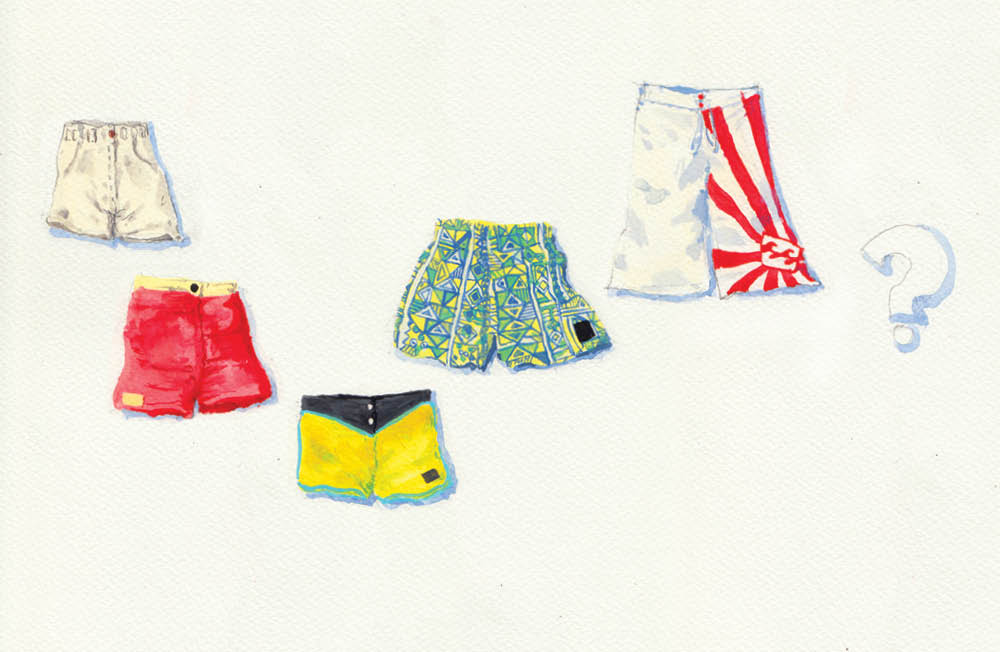The Short History Of Boardshorts
Share
Boardies were once called trunks, and they had belts. The earliest prototypes of what we’d now call boardies were made by a tiny Japanese-Hawaiian couple named Mr and Mrs Nii on the Westside of Oahu. Elvis wore boardies in 1961 when he took up fake surfing for Blue Hawaii. The white trunks came up to his rib cage, but still managed a sly nod to the as-yet unborn Tom Carroll in the legs.
The idea for the snaps and Velcro combination that took Quiksilver into the stratosphere came from Al Green’s early experiments with making wetsuits in 1970. Originally called “Rip Curl Boardshorts”, they quickly became Quiks, the subject of the most famous gentlemen’s agreement in surfing.
Within a couple of years, Gordon and Rena Merchant were furiously snipping and stitching fabrics at their Burleigh flat. Gordon Merchant was a deracinated Maroubra local, and the Gold Coast was far more the natural evolutionary environment for boardshorts than Victoria’s freezing southwest: Billabong was born, and Australian boardies were a two-horse race.
At the revolutionary Stubbies contest in 77, Drouyn’s man-on-man heats weren’t the only innovation – the contest “vests” were actually different-coloured Stubbies shorts – really, really tight ones. According to sensible theory, boardies are long so you don’t rip off your leg hairs when sitting on a board waiting for waves. (This, and many of the other technical features of boardshorts, are lost on southerners, for whom the year-round use of wetsuits means boardies have virtually no technical role in surfing.) But in 77, leg length was rapidly going the way of board length: that is, a race to the bottom.
Keg-huggers were one of the unique contributions Tom Carroll made to our culture, alongside his research into new kinds of injuries, the Snap, and two World Titles. The key to the hugging of the kegs is not, in fact, the eponymous kegs. It’s the thighs: hence the scalloped leg design. If you haven’t got a set of quads capable of crushing the shorts into a squeezebox concertina across the groin, then by definition you’re not running with keg-huggers. Awkward word, isn’t it, groin. Crotch.
Echo Beach was an amalgam of the Martha & the Muffins song title, and a set of patterns taken from Al Green’s love of horseracing. It shouldn’t have worked – what kind of parentage is that? – but this was the 80s, a time when mad stuff frequently worked, and it went berserk. Keg-hugging jockeys’ silks – whoda thought?
Thankfully things loosened up in the latter half of the 80s as Mambo and Okanui went baggy and long respectively. A mere 15 years out from the first range of Quiks and it was Poo-Shooters and hibiscus at ten paces.
But self-expression died soon afterwards with the invention of lightweight, quick-dry material. The unyielding nature of these fabrics had a tendency to wreak havoc with more… yielding parts of the anatomy. Then, like turducken and “clean coal”, someone tried to hybridise two things that are plain old incompatible – neoprene and boardies – creating “wet shorts”. Only Occy in dreadlocks came close to getting away with it.
Celebrity boardshort rosters became a corporate warzone: Occy, Luke Egan, Munga Barry, Parko, Dorian, Taj, and Sunny donning the Bong; while Quik landed Danny Kwock in polka dots, Hakman, Tom Carroll, RCJ and of course, Slater.
In the grunge rock dreariness of the mid-90s, bagged-out long shorts defined the Momentum generation and the entire world followed suit. They were hopelessly impractical – surfing, after all, is not NBA basketball. But somewhere along the way, two arch rivals made their boardies their signature: Kelly’s Quiksilver star trunks from Kelly Slater in Black & White, and Andy’s rising sun shorts, which have since become as revered as the man. In both cases, you’d better shred if you’re going to pull on these patterns and paddle out for a surf.
Nowadays, length is back to normal, and technology’s at a point where boardies feel, to quote the tacky marketing, like you’re not wearing anything at all – retailing at a hundred and thirty bucks and apparently capable of withstanding the forces inside the Hadron Particle Collider. But fashion works in circles, and cut-off jeans are back, at least at Byron. No quick dry, no rash protection and no performance advantage. Bespoke has a lot to answer for.
P.S. Everyone thinks they’re a 32 inch waist. You’re a 36. Get over it.
